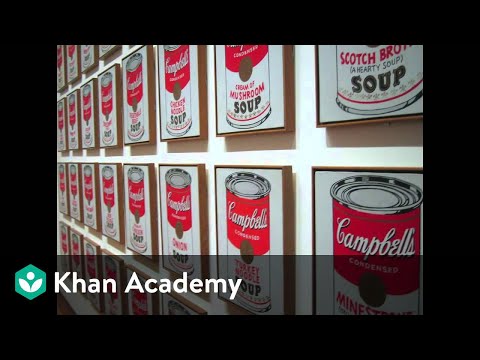14.19: Warhol, Latas de sopa Campbell's
- Page ID
- 103167
\( \newcommand{\vecs}[1]{\overset { \scriptstyle \rightharpoonup} {\mathbf{#1}} } \) \( \newcommand{\vecd}[1]{\overset{-\!-\!\rightharpoonup}{\vphantom{a}\smash {#1}}} \)\(\newcommand{\id}{\mathrm{id}}\) \( \newcommand{\Span}{\mathrm{span}}\) \( \newcommand{\kernel}{\mathrm{null}\,}\) \( \newcommand{\range}{\mathrm{range}\,}\) \( \newcommand{\RealPart}{\mathrm{Re}}\) \( \newcommand{\ImaginaryPart}{\mathrm{Im}}\) \( \newcommand{\Argument}{\mathrm{Arg}}\) \( \newcommand{\norm}[1]{\| #1 \|}\) \( \newcommand{\inner}[2]{\langle #1, #2 \rangle}\) \( \newcommand{\Span}{\mathrm{span}}\) \(\newcommand{\id}{\mathrm{id}}\) \( \newcommand{\Span}{\mathrm{span}}\) \( \newcommand{\kernel}{\mathrm{null}\,}\) \( \newcommand{\range}{\mathrm{range}\,}\) \( \newcommand{\RealPart}{\mathrm{Re}}\) \( \newcommand{\ImaginaryPart}{\mathrm{Im}}\) \( \newcommand{\Argument}{\mathrm{Arg}}\) \( \newcommand{\norm}[1]{\| #1 \|}\) \( \newcommand{\inner}[2]{\langle #1, #2 \rangle}\) \( \newcommand{\Span}{\mathrm{span}}\)\(\newcommand{\AA}{\unicode[.8,0]{x212B}}\)
Steven Zucker y Sal Khan tratan de responder por qué algo se califica como arte. Utilizan Andy Warhol, Campbell's Soup Cans para ilustrar sus puntos.
Andy Warhol, Campbell's Soup Cans, 1962, pintura de polímero sintético sobre treinta y dos lienzos, cada uno de 20 × 16 pulgadas (50.8 × 40.6 cm), (El Museo de Arte Moderno).
Colaboradores
Contenido con licencia CC, Compartido anteriormente
- ¿Por qué es este arte? Andy Warhol, Latas de sopa Campbells. Autor: Sal Khan y Steven Zucker. Proporcionado por: Khan Academy. Ubicado en: www.khanacademy.org/humanidades/art-1010/pop/v/andy-warhol-campbell-s-soup-cans-why-is-este-art. Licencia: CC BY-NC-SA: Atribución-NoComercial-CompartirIgual


